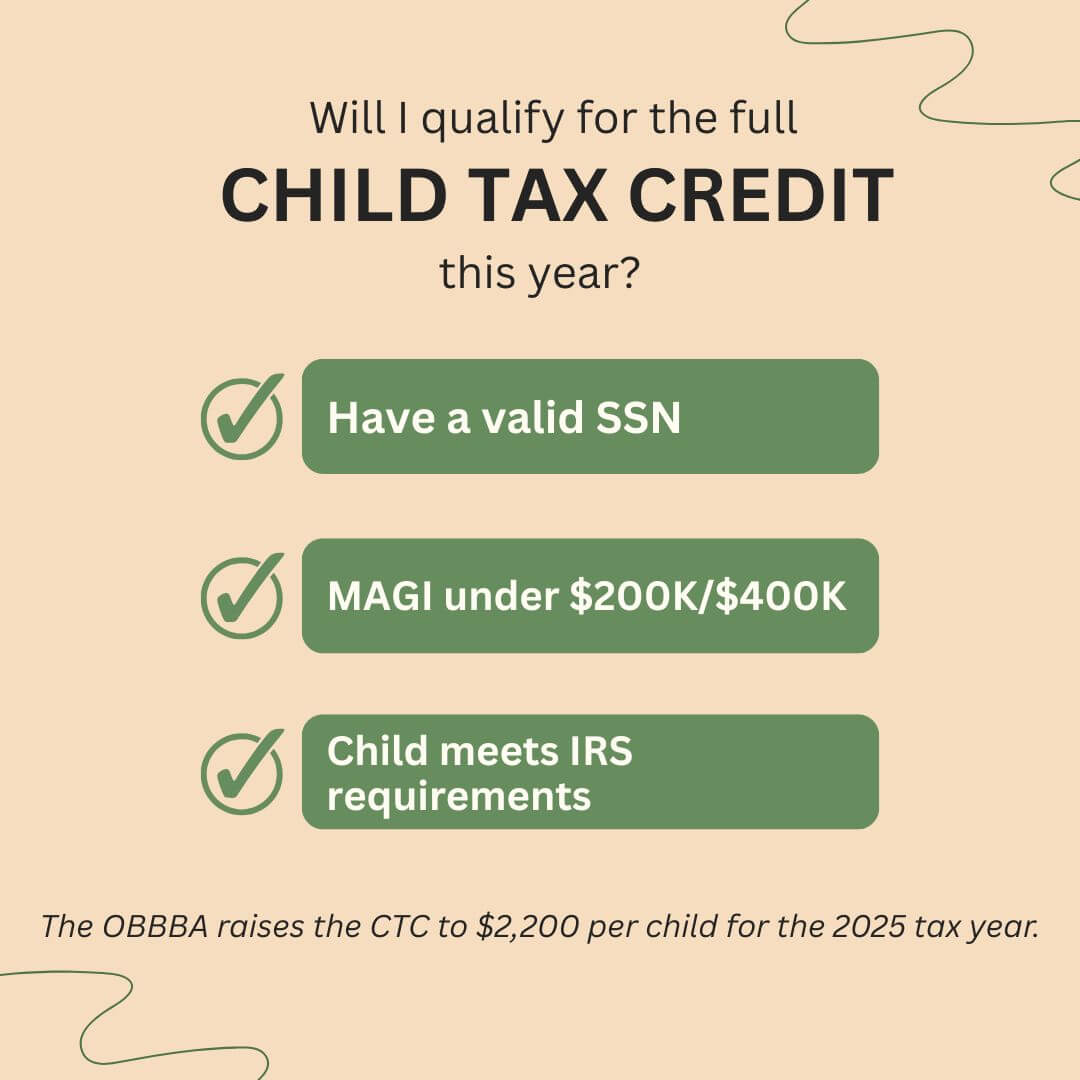Key Takeaways
- The Child Tax Credit (CTC) is now worth up to $2,200 per child for 2025 taxes (filed in 2026).
- Up to $1,700 of the credit is refundable if you don’t owe any taxes.
- Because of the OBBBA, you (or at least one spouse if filing jointly) must have a valid SSN to claim the CTC.
- The 15% of earnings over $2,500 rule remains, meaning some lower-income families won’t see the full benefit.
The One Big Beautiful Bill Act (OBBBA) made some changes to the Child Tax Credit – some Milwaukee families will benefit a little more, and some a little less, depending on your unique situation.
So, what is in the One Big Beautiful Bill about the Child Tax Credit? Let’s talk about it.
What is in the One Big Beautiful Bill about the Child Tax Credit?
The OBBBA bumped the Child Tax Credit up from $2,000 to $2,200 (per qualifying dependent).
Of that, up to $1,700 is refundable. Meaning you can receive it as part of your refund even if you don’t owe any taxes.
What does that mean in real-life terms? If you owe $1,000 in taxes and have one qualifying child, the $2,200 credit wipes out your tax bill and could put part of the remaining amount (up to $1,700 per child if you qualify for the refundable portion) back in your pocket.
Another new OBBBA rule: The taxpayer (you, or at least one spouse if filing jointly) must also have a valid SSN.

How does the Child Tax Credit phase out?
Those filing Married Filing Jointly can get the full credit up to $400,000 Modified Adjusted Gross Income (MAGI); and for all other Southeastern Wisconsin filers, up to $200,000 MAGI.
Here’s how the phase-out formula works: For every $1,000 (or fraction thereof) that your income exceeds the limit, you lose $50 of your total available CTC.
So, say you’re married and have two kids (potential $4,400 credit total) and a MAGI of $415,500. That’s $15,500 over the $400,000 limit. Your credit would be $3,600 total.
Who Qualifies for the Child Tax Credit?
To claim the credit, your child must meet all of the IRS’s qualifying child criteria:
- Must be under age 17 at the end of the tax year.
- Must be your child, stepchild, foster child, sibling, step-sibling, or their descendants (grandchild, niece, nephew, etc.).
- Must be claimed as a dependent on your return and not filing their own joint return, unless just to get a refund.
- Must have lived with you more than half the year (temporary absences like school or hospitalization are exceptions).
- Must not have provided more than half of his/her own support for the tax year.
- The child must have a valid SSN and be a U.S. citizen or resident.
Additionally, your income must fall within the phase-out limits discussed above.
How does the Additional Child Tax Credit Work?
If your CTC is larger than your total tax liability, you may qualify for the Additional Child Tax Credit (ACTC) (which is the refundable part).
The IRS calculates it by taking your earned income, subtracting $2,500, and multiplying what’s left by 15%. The result (up to $1,700 per child) is what you can get refunded.
So, if you earned $30,000 and have one qualifying child, your ACTC would be $4,125.
BUT since the max refundable portion is $1,700, that’s your cap.
This 15% phase-in rate and the $1,700 cap didn’t change with the new OBBBA rules. Which means if your household is in a lower-income position, you might still only qualify for part of the full credit. Unfortunately, this ACTC formula still favors higher earners who are above that phase-in threshold.
FAQS
“Can I claim the Child Tax Credit for a newborn in 2025?”
Yes, if your child was born anytime during 2025 and meets all the other tests (age, residency, support, etc.).
“Is the Child Tax Credit fully refundable for everyone?”
No. The refundable part caps at $1,700 per child, and you must have at least $2,500 in earned income.
“Can I claim the Child Tax Credit if I share custody of my child?”
Only the parent who claims the child as a dependent on their return can take the credit. You can’t split it.
“Can I get the Child Tax Credit if I don’t owe taxes?”
Yes, but only up to the refundable limit ($1,700 per child). The rest of the credit can’t be used beyond that.
“Does the Child Tax Credit impact the Earned Income Tax Credit?”
You can claim both if you qualify. The EITC is separate and based on earned income and family size.
“What’s the difference between the Child Tax Credit and the Additional Child Tax Credit?”
The CTC is the full credit amount; the ACTC is the refundable portion you can get as cash back.
Final word
To wrap up what is in the One Big Beautiful Bill about the Child Tax Credit: Yes, the legislation tacked an extra two hundred dollars onto the credit. But the refund phase-in rate and cap didn’t change, and you (as the taxpayer) now have to have an SSN. Which could box you out of getting the full benefit if you’re part of a lower-income or mixed-status family.
So, if you’re looking at claiming the CTC at tax time, let’s have a conversation about it early. I can help you make sure you and your dependents have all the qualifying details sorted. And if income is the hurdle, we can help you time it to legally minimize your MAGI.
Let my team and I help you secure every dollar you’re eligible for:

